MARIANI’SVirtual
Gourmet
December
1, 2013
NEWSLETTER
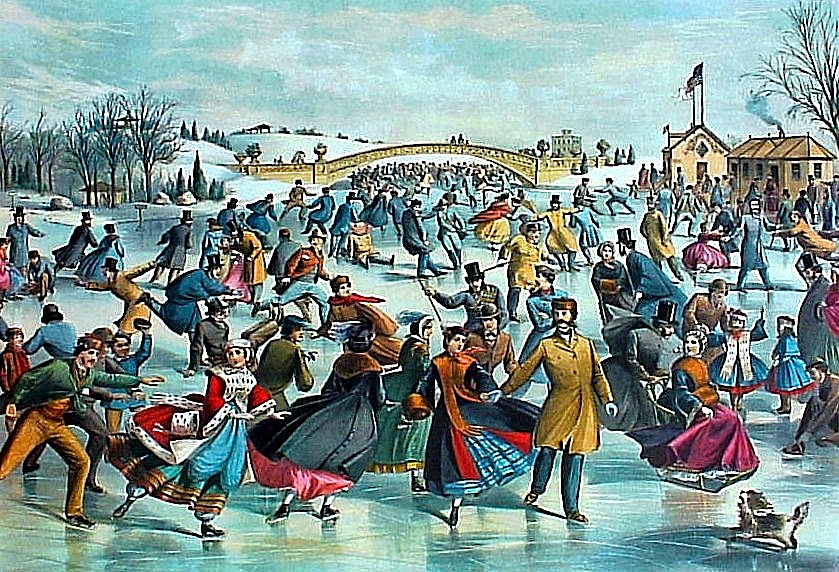
GIFT BOOKS FOR THE SEASON
by John Mariani
REMEMBERING JEAN BANCHET
by John Mariani
NEW YORK CORNER
East 12th Osteria
by John Mariani
NOTES FROM THE WINE CELLAR
LIVIO FELLUGA PIONEERS WHITE WINES OF ITALY
by John Mariani
❖❖❖
by John Mariani
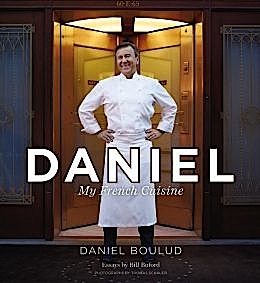
DANIEL: MY FRENCH CUISINE by Daniel Boulud (Grand Central, $60)--Master chef has written several fine cookbooks and one memoir, but this is easily his best and most revealing, with an essay by Bill Buford. The home cook may not want to attempt many of the dishes without the help of a brigade of staff, but the recipes are more fascinating for their rigor and how they are distinguished from so much that passes for sleight-of-hand cookery these days. Most fascinating of all are those ancienne recipes that Boulud attempts to recreate, only to find that his predecessors were extraordinarily adept at turning out dishes like coulibiac, canard à la presse, and turbot soufflé for which Boulud had to puzzle out the secrets of success with such dishes. And he did have the help of an entire brigade.
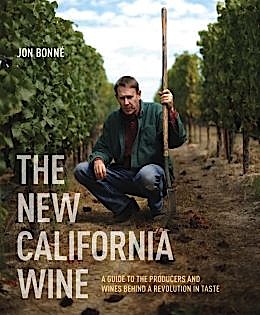 THE NEW CALIFORNIA WINE by Jon
Bonné ( Tenspeed, $35)--The unsmiling face of
author Jon Bonné of the cover of this splendidly
researched "guide to the producers and wines behind a
revolution in taste" lets you know this is not just
another paean to the mutual admiration society that so
often causes marketing to trump the truth. It's
hard work out there in the vineyards, if only to keep
all the players straight. Bonné's enormous
respect for pioneering figures in California is not
without pointed criticisms and he is very good at
separating fact from myth and hype from a good story. He
differentiates between the old timers and new money, the
effects of the global market on decisions made in the
winery rather than the vineyard. Bonné
knows his terroir and the people who work within
it. His remarks on styles of wines are critical to
understanding what is happening in California at a
transitional time.
THE NEW CALIFORNIA WINE by Jon
Bonné ( Tenspeed, $35)--The unsmiling face of
author Jon Bonné of the cover of this splendidly
researched "guide to the producers and wines behind a
revolution in taste" lets you know this is not just
another paean to the mutual admiration society that so
often causes marketing to trump the truth. It's
hard work out there in the vineyards, if only to keep
all the players straight. Bonné's enormous
respect for pioneering figures in California is not
without pointed criticisms and he is very good at
separating fact from myth and hype from a good story. He
differentiates between the old timers and new money, the
effects of the global market on decisions made in the
winery rather than the vineyard. Bonné
knows his terroir and the people who work within
it. His remarks on styles of wines are critical to
understanding what is happening in California at a
transitional time.
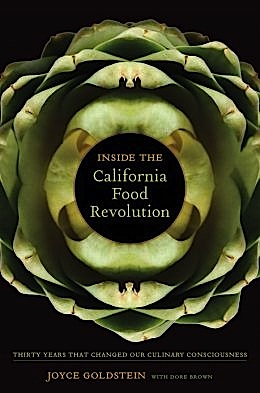
INSIDE
THE CALIFORNIA FOOD REVOLUTION by Joyce Goldstein
with Dore Brown (U. of California, $34.95)--Lively
history told by someone who was part of it always makes
for the most engaging books, and award-winning
restaurateur and author Joyce Goldstein certainly
qualifies as one in the vanguard of a culinary
revolution no one saw coming in America--and certainly
not in California--that transformed the way
Americans eat. This is a story of eccentrics,
hard-nosed business people, manic egos, and the
open-mindedness of young people willing to go against
established traditions--if only to annoy their
parents--and to come up with something new, fresh, and
healthful. The book is full of personalities that
include Alice Waters, Jeremiah Tower, Caroline Bates,
Darrell Corti, Thomas Keller, and so many others who
have enriched our lives with good taste and a boundless
youthful energy that made everything possible.
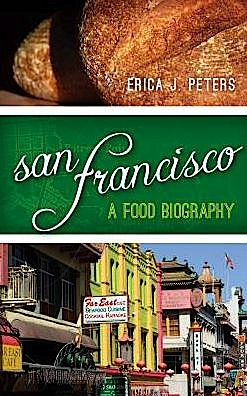
SAN FRANCISCO: A Food
Biography by Erica J. Peters (Altamira,
$38)--One might read Eric Peters' book right
alongside Joyce Goldstein's and compare notes, but
Peters' study focuses in on America's most dynamic food
city from its earliest days, when the Spanish settled
missions in the territory through the great migration of
Asian immigrants to the port city. San Francisco's
energetic self-promotion in the 19th century was stopped
short by the 1906 earthquake only for a heartbeat before
its neighborhoods developed mini-food cultures enriched
by the bounty of the Pacific and the provender of an
exploding agriculture that was to fee America.
Russians, Italians, Vietnamese are all a part of the
story, as well as many dishes, like sourdough bread,
crab Louis, turkey Tetrazzini, and cioppino that were
part of the ethnic diversity in the Bay City.
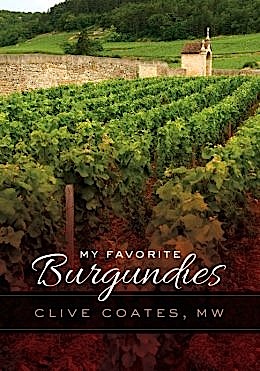
MY
FAVORITE BURGUNDIES by Clive Coates (U. of
California, $60)--Clive Coates, a Master of Wine, does
not turn out breezy memoirs; neither does he treat his
subjects in the base vernacular that passes for wine
commentary these days. His acumen is unchallenged,
not least on the subject of Burgundy, his thoughtfulness
provocative, and his opinions on individual wines as
close to definitive as subjectivity can ever be. You can
skip the reams of wine notes--the usual piling on of
adjectives like "concentrated," "profound," "clumsy,"
"closed"--and read with far more pleasure his in-depth
essays on regions and the commentaries of vintners he
has known for many, many years. Coates trods those
vineyards, sniffs the air, tastes the grapes, and does
much more than just blow through barrel samples at the
wineries. If you want to understand the issues
whirling through Burgundy right now, Coates is the man
to alert you first and foremost.
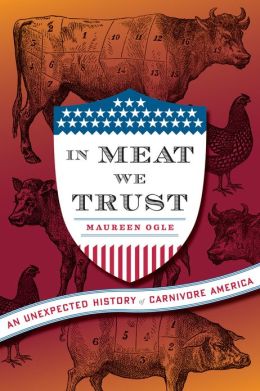
IN MEAT WE TRUST by Maureen Ogle
(Houghton Mifflin Harcourt, $28)-- I'm not sure what the
cover line "An unexpected history of Carnivore America"
is supposed to mean, but no book on the subject has been
more thorough or up to date in its assemblage of data
set within a narrative that shows how American became so
happily a nation of meat eaters. It is a story of
vast territories in the west tamed by individuals and of
the conglomerates that later took them over, not always
with any degree of fairness. American
technological genius is demonstrated throughout,
explaining the movement, slaughter and distribution of
American meat to market has been so amazingly
streamlined for maximum economy and low prices. The
battles between agronomists, farmers, academics, and
politicians makes, if not engrossing reading, highly
informative history. The book is a bit of a grind,
but then so is the U.S. meat industry.
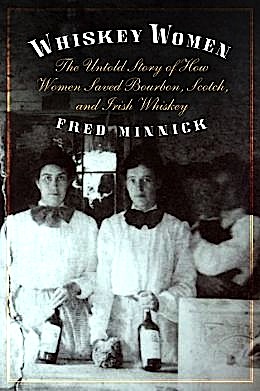
WHISKEY WOMEN
by Fred Minnick (Potomac Books, $26.95)--Ask even
the most committed spirits aficionado about the
contributions of women to the bourbon, Scotch and Irish
whiskey industry, and you'll probably draw a
blank. Minnick, an elegant writer and fastidious
scholar, not only fills in those blanks but shows how
women at Bushmills, Maker's Mark, and Johnnie Walker owe
much of their success, even salvation, to women like
Bessie Williamson, who became the head of Laphroiag
Distillery and spokesman for the troubled Scotch
industry. Minnick takes the reader back to the earliest
days of distilling history to show women's involvement,
which continued in a pretty rough-and-tumble way
straight through Prohibition, like Cleo Lythgoe, known
as the Queen of the Bootleggers, who retired a
millionaire. The battle among women on opposite
sides of the temperance movement is duly covered as both
a sociological and theological struggle for a national
identity and brings everything up to the present when
many women sit at the head of spirits companies and
direct their policies.
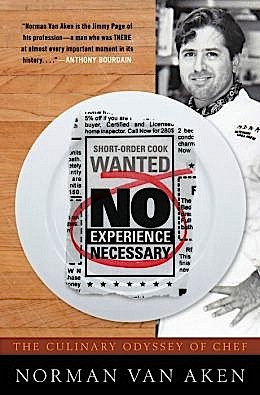
NO EXPERIENCE NECESSARY by Norman
van Aken (Taylor, $24.95)--In a more personalized
way, Norman van Aken has told the story of American
cuisine's evolution as a chef's "culinary odyssey,"
charting how so many of the most innovative chefs of the
past forty years started out as short order cooks who
fell into the profession by accident and stayed on to
create a revolution, in this case the so-called "New
Floridian Cuisine," with colleagues like Robin Haas,
Doug Rodriguez, and Mark Militello, utilizing the best
so-often neglected ingredients of the South to craft
dishes that were unlike any others from around the
U.S. It is a rollicking story, full of near-misses
and worthwhile achievements, and van Aken tells it with
gusto.
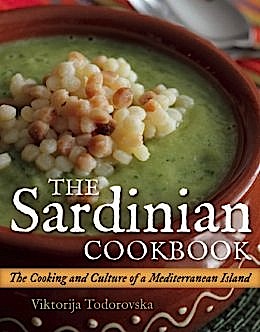
THE SARDINIAN COOKBOOK by
Viktorija Todorovska (Agate, $22.95)--Sardinia is
a large Mediterranean island largely forgotten in the
discussion of Italy's food culture, so this cookbook is
long overdue. To a great extent Sardinian food is
of peasant origins without as many cross-cultural
influences as had Italy's mainland, and, being an
island, Sardinia maintained an independent streak that
has maintained the traditions of its food, not least in
the dialectical names for it, like pane carasau, malloreddus,
seadas and lampazu,
with lavish use of bottarga. The island's use of
couscous is widespread and its breads emblematic.
The recipes here, with excellent headnotes, are easy to
work with. The author runs a cooking school and has
followed up her widely praised The Puglian Cookbook with
this well-illustrated volume.
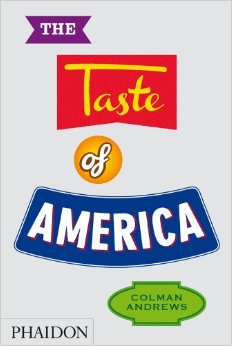
THE TASTE OF AMERICA
by Colman Andrews (Phaidon, $29.95)--A nicely
packaged, silver-coated big book of engaging one-page
essays on beloved American foods by one of America's
finest food chroniclers. Colman Andrews not only
knows his stuff, he writes about it with wit and charm,
as he warns about eating beignets dusted with powdered
sugar: "Do not visit Cafe du Monde, in the French
Quarter of New Orleans, wearing black--not, that is, if
you're planning on eating something." The
selection of 250 items seems random, including
yellowfin tuna and alligator along with candy corn and
chocolate mice. But it's a lot of fun and you'll learn
here some culinary oddities well worth knowing, like the
fact that cheese crackers were first produced at the
Center Serving Persons with Mental Retardation in San
Felipe, Texas.
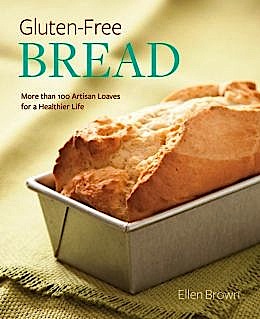
GLUTEN-FREE BREAD by Ellen Brown
(Running Press, $23)--"No one eating my recipes
should ever say, `Not bad for gluten-free," writes the
ever ebullient Ellen Brown, who, as far as I know does
not maintain a gluten-free diet, nor do I. So my
interest in the book was as much about how she could
pull it off as it was about how broad and deep the
subject really is and, for many people, how serious. So
many of the recipes here are mouthwatering whatever your
lifestyle--millet buckwheat bread, muesli bread,
sourdough boule,
parmesan shallot rounds, lavash, and so many more.
The breads look just as good in photographs as they
sound, right down to the last page on maple walnut
breakfast rolls. What's not to love?
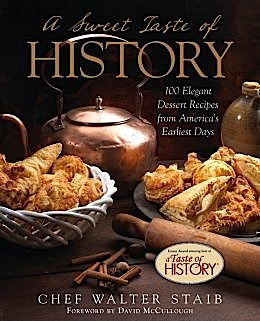
A SWEET TASTE OF HISTORY
by Walter Staib ( Lyons, $29.95)--The irrepressible,
hard-working Walter Staib, host of the PBS series "A
Taste of History," here gives us a companion
volume that demonstrates the amazing array of desserts
that originated in the old colony days of America, when
even a newly arrived settler could enjoy sweets
unavailable back in Europe. Staib doesn't keep strictly
to the time period--macadamia nuts and ricotta were not
to be found in Thomas Jefferson's larder--but
the spirit is all here in recipes like Johnny
Appleseed's pie, Indian pudding, charlotte russe, spritz
cookies, plum fool, and sweet potato biscuits. The
photos are evocative, and the historical anecdotes fun
throughout.
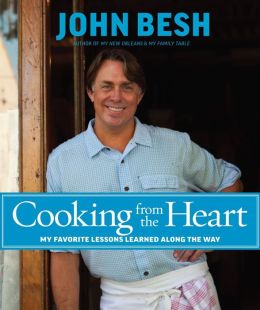
COOKING
FROM THE HEART by John Besh (Andrews
McNeel, $40)--The subtitle here is "My Favorite Lessons
Leaned Along the Way," and charts how his cuisine has
been formed by attending to those epiphany moments
culled from his mentors, many of them from the South of
France, whose influences you can see and taste in the
140 recipes here, like fava bean and tomato ragôut
tartines;
mussel and Swiss chard soup; a "proper bouillabaisse";
and sea bass Provençal, any of which might fit
into his New Orleans repertoire at his restaurants
there. The evocative illustrations and photos are
exceptional, so much so that you may want to Xerox the
recipes and keep the book free of sauce stains.
. .
. And lest I forget. . .
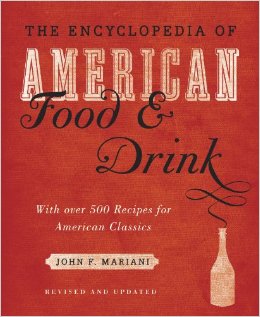
THE ENCYCLOPEDIA OF AMERICAN FOOD & DRINK
by John F. Mariani (Bloomsbury USA, $35)--Modesty
forbids me to praise my own new book, but let me
proudly say that it is an extensive revision of the
4th edition that appeared more a decade ago, before
locavores, molecular cuisine, modernist cuisine, the
Food Network, and so much more, now included. Word
origins have been completely updated, as have per
capita consumption and production stats. Most
important, for the first time since publication in
the 1980s, the book includes more than 100
biographies of Americans who have changed the way we
cook, eat and drink, from Fannie Farmer and Julia
Child to Robert Mondavi and Thomas Keller. a
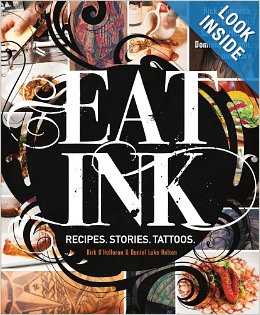
❖❖❖
Remembering Jean
Banchet
by John Mariani
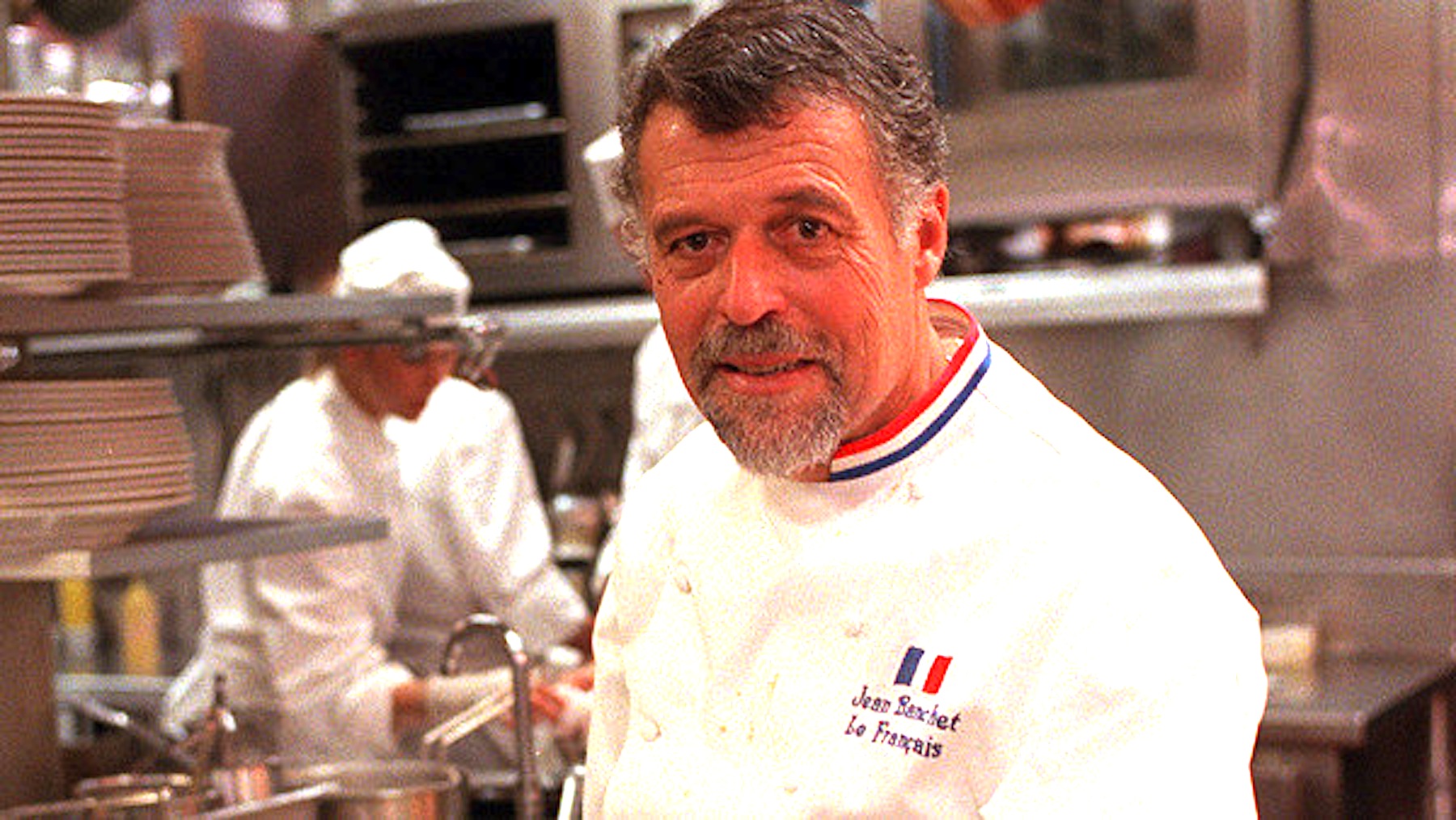 The
passing away of Jean Banchet this week at the age of 72
was the loss of an master chef whose eminence in
the 1970s and 1980s was of such brightness that his
restaurant, Le Français—30 miles from Chicago in
Wheeling, Illinois—was more than once called the finest
in America.
The
passing away of Jean Banchet this week at the age of 72
was the loss of an master chef whose eminence in
the 1970s and 1980s was of such brightness that his
restaurant, Le Français—30 miles from Chicago in
Wheeling, Illinois—was more than once called the finest
in America.
I knew Jean pretty well, having often
been astounded by the lavish excellence of his cooking
and presentations at a time when French restaurants in
the USA had become stultified in both cuisine and
service. His cooking was among my first introductions to
the glory of haute cuisine, no matter what the cost. And
you got what you paid for, which back then was about $75
per person, with wine
from a dauntingly rich list, among which were some of
the new impressive bottlings then coming out of
California .
Banchet,
born in Roanne, worked alongside many of the masters of
the burgeoning “la nouvelle cuisine” in the late 1960s,
including Paul Bocuse, but he saw that America had an
immensely enticing culinary future and so relocated in
1968 to become chef of a Playboy resort in Wisconsin,
then to open Le Français in 1973, bringing an
extravagant style of cooking and service rooted in the
innovative ideas of chefs like Bocuse, Roger
Vergé, the Troisgros brothers, Alain Chapel, and
other young men who had graduated from older kitchens
where no one ever knew the name of the chef, who,
working within an environment of strict class
structures, maintained French classicism and ignored any
thought of changing
them in any way.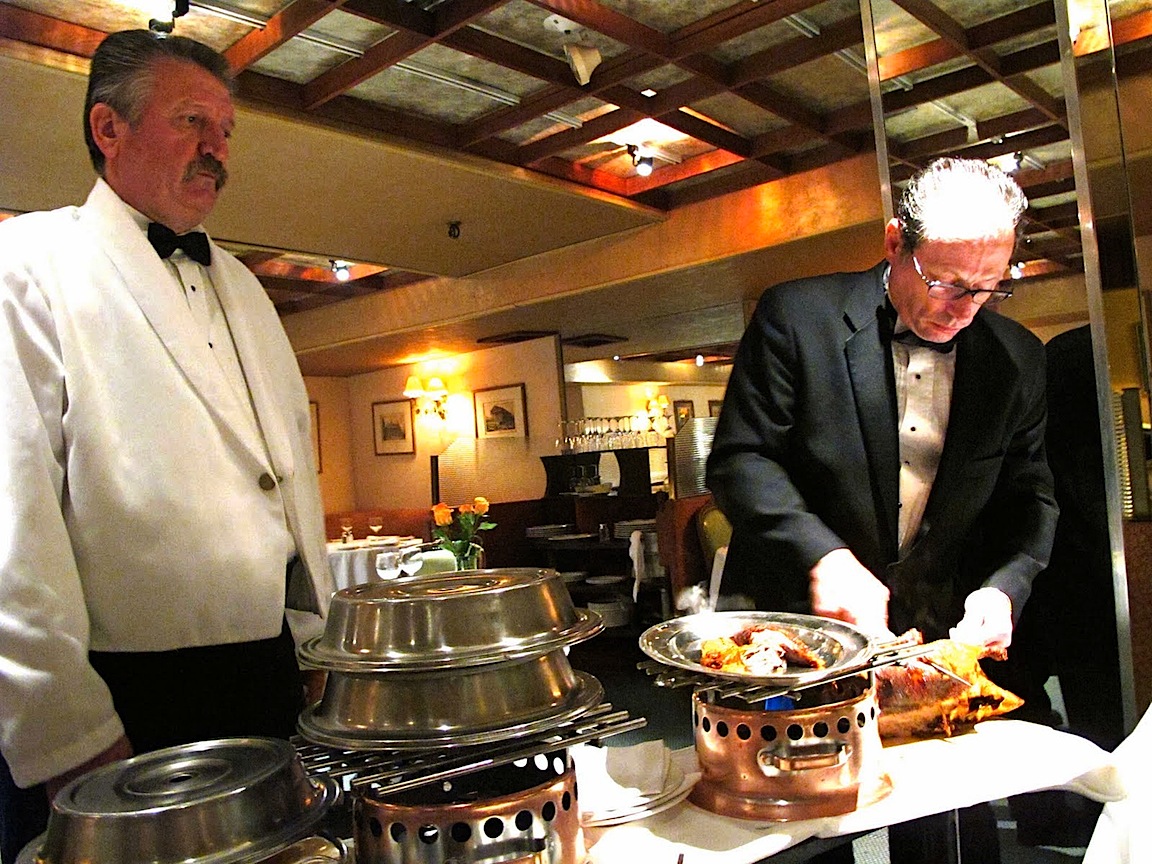
La
nouvelle cuisine was heralded as breaking away from all
that, but in fact, it only updated the basics of French
haute cuisine, which always began with the sauces. The new chefs
added to the repertoire by incorporating new
ingredients, shortening cooking times and making plate
presentations—usually on exquisite Villeroy & Boch
china—colorful and dramatic, with swirls and patterns of
sauce drawn and dripped on the plates. La nouvelle
cuisine was often credited with lightening French
cuisine, which was principally an alternative menu at
Michel Guérard’s spa Les Prés
d’Eugènie, but in fact most nouvelle recipes were
awash in very rich beurre blanc, foie gras, and pastry
cream.
Banchet took to this style with gusto, and, with his
impressive Van Dyke beard and uncommonly tanned face, he
strode the dining room with a charismatic bonhomie,
urging patrons—many of whom flew into Chicago just to
dine at Le Français—to try something they’d never
tasted before.
I’ll never forget his lobster
sausage, his array of pâtés with eight
spreads, Dover sole and lobster mousse en crôute,
salmon and avocado in aspic with vinaigrette and tomato
coulis, and strawberry sablé.
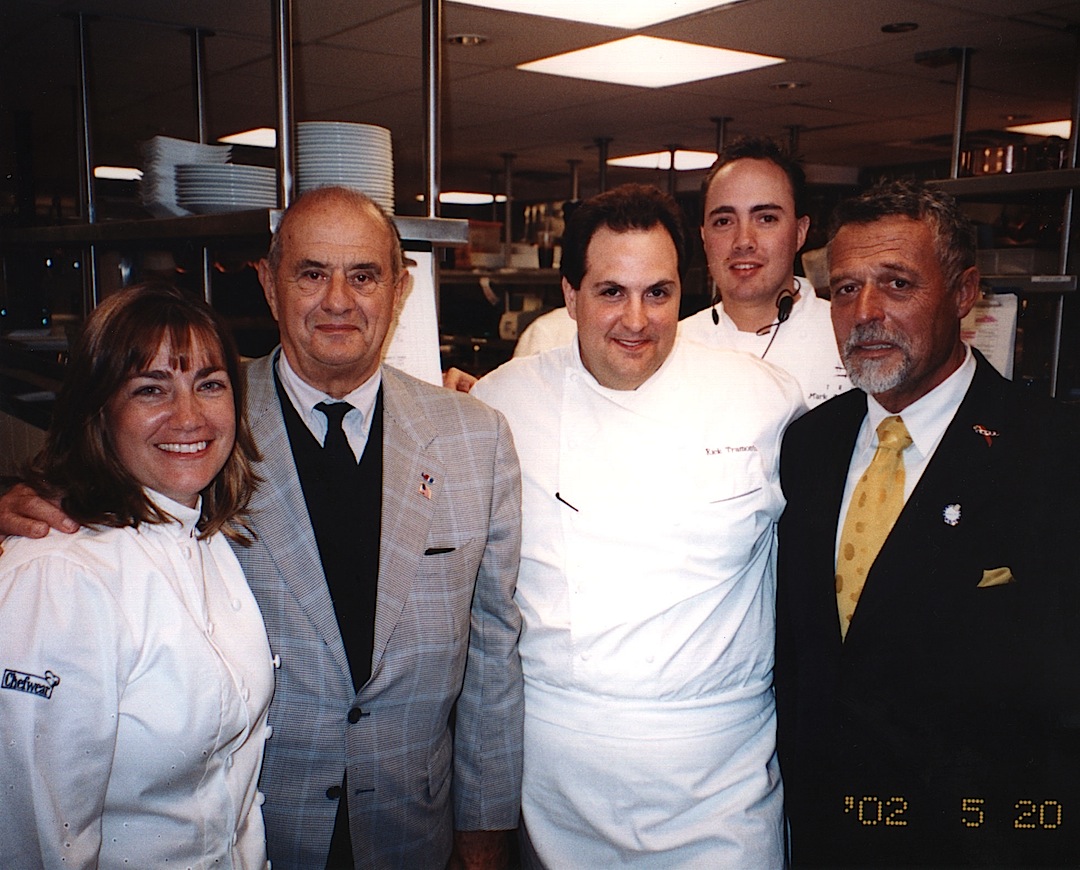 Everything at Le
Français was over-the-top—the décor, the
heavy silverware, the silver carts, and the swooping
wait staff in tuxedos. Banchet loved the limelight and
sharing his good fortune with his French colleagues. I
remember a gargantuan meal he held in honor of Paul
Bocuse and his chefs, who had flown to the U.S. for the
dinner, arriving from Paris with no time to unwind
before getting on a bus to Wheeling, arriving an hour
later to flutes of Champagne and a recording of “La
Marsellaise.”
Everything at Le
Français was over-the-top—the décor, the
heavy silverware, the silver carts, and the swooping
wait staff in tuxedos. Banchet loved the limelight and
sharing his good fortune with his French colleagues. I
remember a gargantuan meal he held in honor of Paul
Bocuse and his chefs, who had flown to the U.S. for the
dinner, arriving from Paris with no time to unwind
before getting on a bus to Wheeling, arriving an hour
later to flutes of Champagne and a recording of “La
Marsellaise.”
The printed menu had 12 courses on it, one seemingly
richer than the last, and each table was set with a
molded chocolate figure of Bocuse. Things got
underway late, and by the third course the French were
drooping, Bocuse was rubbing his eyes to stay awake, and
the evening threatened to collapse into a drowsy
mistake. Banchet,
seeing the tilt of things, immediately cancelled four or
five courses and, to great applause, brought the evening
to a close around midnight.
Photo of Gale Gand,
Paul Bocuse, Rick Tramonto, unknown chef, Jean Banchet.
Banchet
went on to open and close restaurants in Atlanta and one
in Florida, but none had the cachet of Le
Français, which closed, under different
ownership, in 2007. But even if still around, its
cuisine and style would be considered hopelessly out of
synch with the gimmicks of molecular cuisine that now
get the hype in Chicago.
Yet if Le Français were still around and
the ebullient Jean Banchet there to lend his indomitable
spirit to it, many might still consider it one of the
greatest and certainly grandest restaurants in America.
❖❖❖
NEW YORK CORNER
by
John Mariani
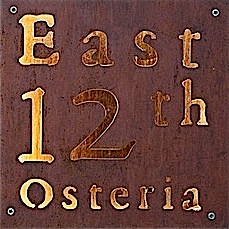
197 First Avenue
212-432-1112
http://www.east12osteria.com
The
traditional lines between an Italian trattoria, osteria
and ristorante have
become blurred over the past decade. A trattoria
used to mean a casual, family-owned, home-style place to
eat regional food; an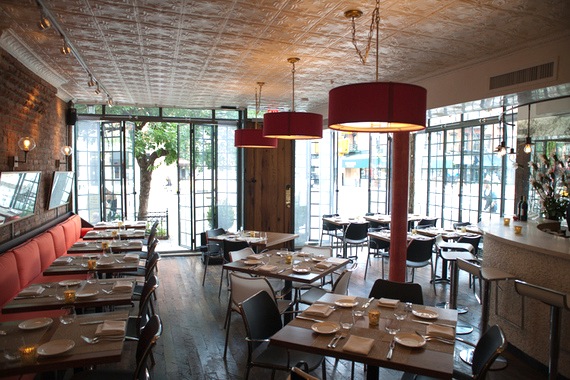 osteria was originally a wine
tavern, and a ristorante was a more upscale dining
place.
osteria was originally a wine
tavern, and a ristorante was a more upscale dining
place.
So in its handsome look, inventive
cooking and highly regarded chef-owner East 12th
Osteria seems too humble a name, trattoria closer, and
ristorante too stiff.
It is by no means a formal Italian restaurant: it sits
comfortably on a corner of First Avenue in New York’s
East Village and the décor and good lighting
makes it as much a place to drop into for a glass of
wine and a pasta as it is to sit down to a lavish meal,
all without spending a fortune. Just noshing
on the housemade bread and grissini sticks
is reason enough to come by.
The floor is hardwood reclaimed from a
250-year-old Maine home; the brick walls and red
banquettes provide warmth and color, the tilted mirrors
give an illusion of spaciousness, the glass wall and
sheer curtains a romantic cast, and the Gascon Stua
armchairs will put you in mind of a chic new spot in
Rome’s Trastevere or Milan’s Naviglia neighborhoods.
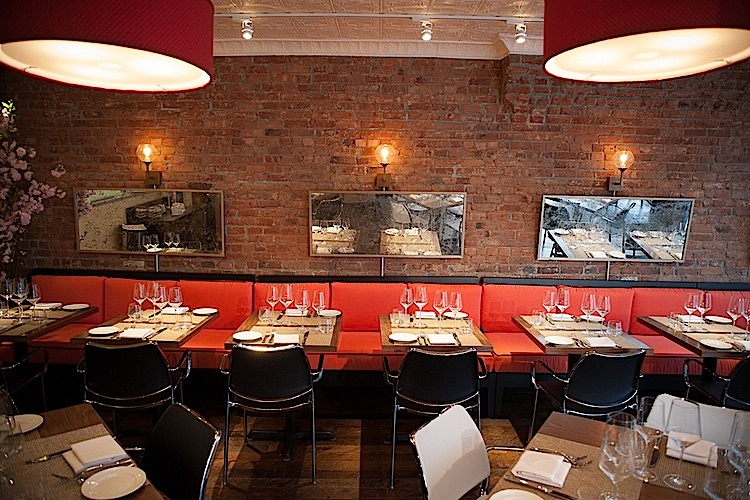 Back in the cramped kitchen,
working at a feverish pace, Chef/owner Roberto Deiaco,
formerly of Armani Ristorante uptown, is breaking past
all the clichés of contemporary New York Italian
cooking—no thin-crust pizzas or $50 veal parm--starting
with a bright antipasto of beets, broiled tomino cheese,
frisée and a tangy sweet quince dressing. The crudi here—well
priced at $24—include the freshest in the market,
perhaps blue fin tuna, white sturgeon or
langoustines. The big fatted sea scallop is eared
and then given a benediction of white truffle shavings (below).
Back in the cramped kitchen,
working at a feverish pace, Chef/owner Roberto Deiaco,
formerly of Armani Ristorante uptown, is breaking past
all the clichés of contemporary New York Italian
cooking—no thin-crust pizzas or $50 veal parm--starting
with a bright antipasto of beets, broiled tomino cheese,
frisée and a tangy sweet quince dressing. The crudi here—well
priced at $24—include the freshest in the market,
perhaps blue fin tuna, white sturgeon or
langoustines. The big fatted sea scallop is eared
and then given a benediction of white truffle shavings (below).
Italian restaurants are, of course, defined by
the quality of their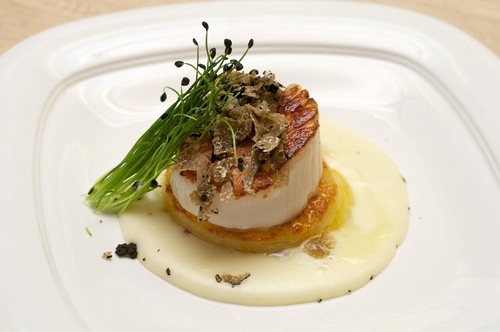 pasta, and Deiaco’s are quite
obviously rendered with exacting care. Pumpkin gnocchi—just right
for the holidays—are lavished with a rich Gorgonzola
sauce and given unexpected texture and bite from bacon
and almonds. His
risotto is perfectly cooked till just tender enough to
give some chew, along with radicchio and grape must, and
his ricotta ravioli, delicately rolled out, is stuffed
with quail’s egg with a bright green zucchini pesto
sauce and truffles.
pasta, and Deiaco’s are quite
obviously rendered with exacting care. Pumpkin gnocchi—just right
for the holidays—are lavished with a rich Gorgonzola
sauce and given unexpected texture and bite from bacon
and almonds. His
risotto is perfectly cooked till just tender enough to
give some chew, along with radicchio and grape must, and
his ricotta ravioli, delicately rolled out, is stuffed
with quail’s egg with a bright green zucchini pesto
sauce and truffles.
After the pastas, a lot of
Italian chefs coast, but Deiaco’s olive oil poached
lobster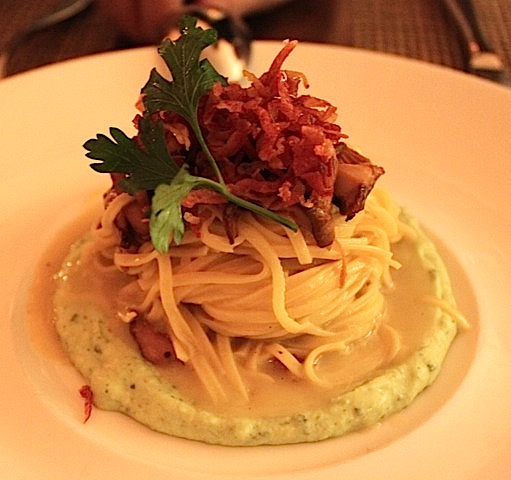 with chick peas and escarole
soars right along with what precedes it, and I loved his
duck, richly flavorful, with a Champagne grape essence
and a potato cake. The only disappointment of a recent
evening was a veal fillet in an almond crust with apple
puree and a dark beer reduction that just didn’t jibe or
taste particularly Italian.
with chick peas and escarole
soars right along with what precedes it, and I loved his
duck, richly flavorful, with a Champagne grape essence
and a potato cake. The only disappointment of a recent
evening was a veal fillet in an almond crust with apple
puree and a dark beer reduction that just didn’t jibe or
taste particularly Italian.
The kitchen is putting considerable effort into
its desserts—rarely a strong point in Italian
restaurants—including the housemade ice creams and sorbetti and a
chocolate fondant with hazelnut cream and ripe
raspberries.
At
a time when so many chefs have abandoned their own
kitchens in favor of self-promotion, it is wholly
refreshing to see a chef working so hard on every dish
for every guest throughout the night. Whatever name
East 12th Osteria goes by, it
will soon be known as the place Roberto Deiaco and his
wife Giselle have made entirely their own.
East 12th Osteria is open nightly
for dinner and on Sunday for brunch. Antipasti
$11-$24, pastas $19-$27, main courses
$22-$39.
NOTES FROM THE WINE CELLAR
Pioneer of Pinot Grigio Takes a
New Tack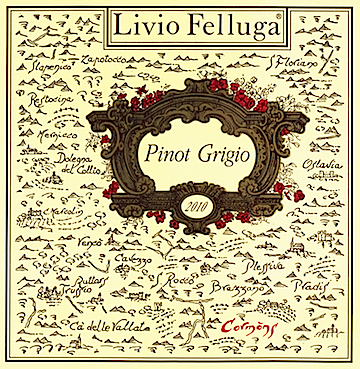
by John Mariani
You can thank Livio Felluga of Friuli for
two things: one, for bringing pinot grigio to the
attention of the American public, and, two, for
unleashing a tsunami of bad pinot grigio on the
American public.
I remember very clearly the
first time I tasted Livio Felluga’s pinot grigio back
in 1978 in New York. Prior to that there wasn’t a
single Italian white wine I would have rated as
anything more than pleasant. Not that there was
much to judge by: soave (often sold in a green bottle
shaped like a fish) and verdicchio were about the only
examples available.
So I was amazed by the richness,
complexity, and aromatics of the Felluga pinot grigio I
tasted, as well as by its coppery color—called
ramato—that made many potential buyers think the wine
had gone bad.
But Felluga’s wine was widely praised
by the critics, though its production and distribution
was narrow. It took American importers to capitalize on
the novelty of pinot grigio—David Taub, who brought in
Cavit wines and Tony Terlato who brought in Santa
Margherita—both enormously successful, so much so that
today pinot grigio is the top-selling Italian wine in
the U.S. and U.K., with more than 600 producers making
about 9 million litre cases, with 90 percent exported,
principally to the United States, Germany and UK.
Most of them made plonk from any
region of Italy the grape would grow. Thus, while Livio
Felluga is still the high standard for pinot grigio, the
company has focused more on its own proprietary wines,
Terre Alta and Abbazia di Rozassa.
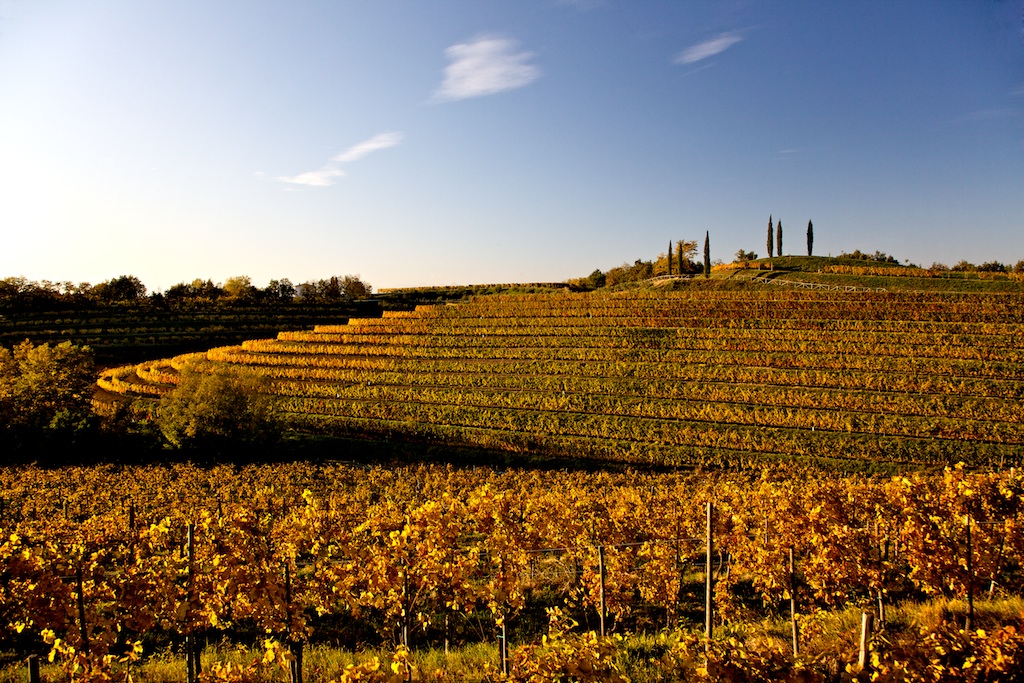 Livio Felluga, now in his
nineties, founded his winery in 1955 on the northern
region of Friuli Venezia-Giulia, bottling his wines at a
time when most others made and sold wine in bulk. By the
1960s he was using the most advanced vinicultural
techniques to prevent oxidation and to keep his wines
fresh and longlived, which came to be called the
“Friulian method.”
Livio Felluga, now in his
nineties, founded his winery in 1955 on the northern
region of Friuli Venezia-Giulia, bottling his wines at a
time when most others made and sold wine in bulk. By the
1960s he was using the most advanced vinicultural
techniques to prevent oxidation and to keep his wines
fresh and longlived, which came to be called the
“Friulian method.”
Today the family, which includes his children, Maurizio, Elda,
Andrea and Filippo, oversees 395 acres in the
Collio and Colli Orientali del Friuli regions (left), producing
800,000 bottles yearly, for sale in 70 countries.
Felluga still
produces a great deal of pinot grigio—and I still think
it’s the best in Italy—but has broadened the vineyards
with many other varietals like pinot bianco, chardonnay,
sauvignon blanc, picolit, refosco, sauvignon blanc and
friulano, as well as making red wines from refosco dal
peduncolo rosso, merlot, and pignolo.
The family is most proud of two
current wines: the
single vineyard “Super Friulano” called Terre Alte (“Highlands”, made since
1981 from a blend of Friulano, Pinot Bianco, and
Sauvignon Blanc, but only in excellent vintages. It now
carries the Italian wine law designation of IGT
(indicazione geografia tipica.
The other is Felluga's’s newest
project, Abbazia di Rosazzo, made on the estate of an
historic abbey (below)
with roses, leased to the family since the 1970s. First
produced in 2009, within two years the wine was awarded
the prestigious designation of DOCG Rosazzo
(denominazione di controllata e guarantita). The wine is
a blend of historic strains of pignolo, picolit and
ribolla gialla.
After the grapes go through a cold
soaking and pressing, the must is fermented in steel tanks with
Friulian yeasts, then racked into oak casks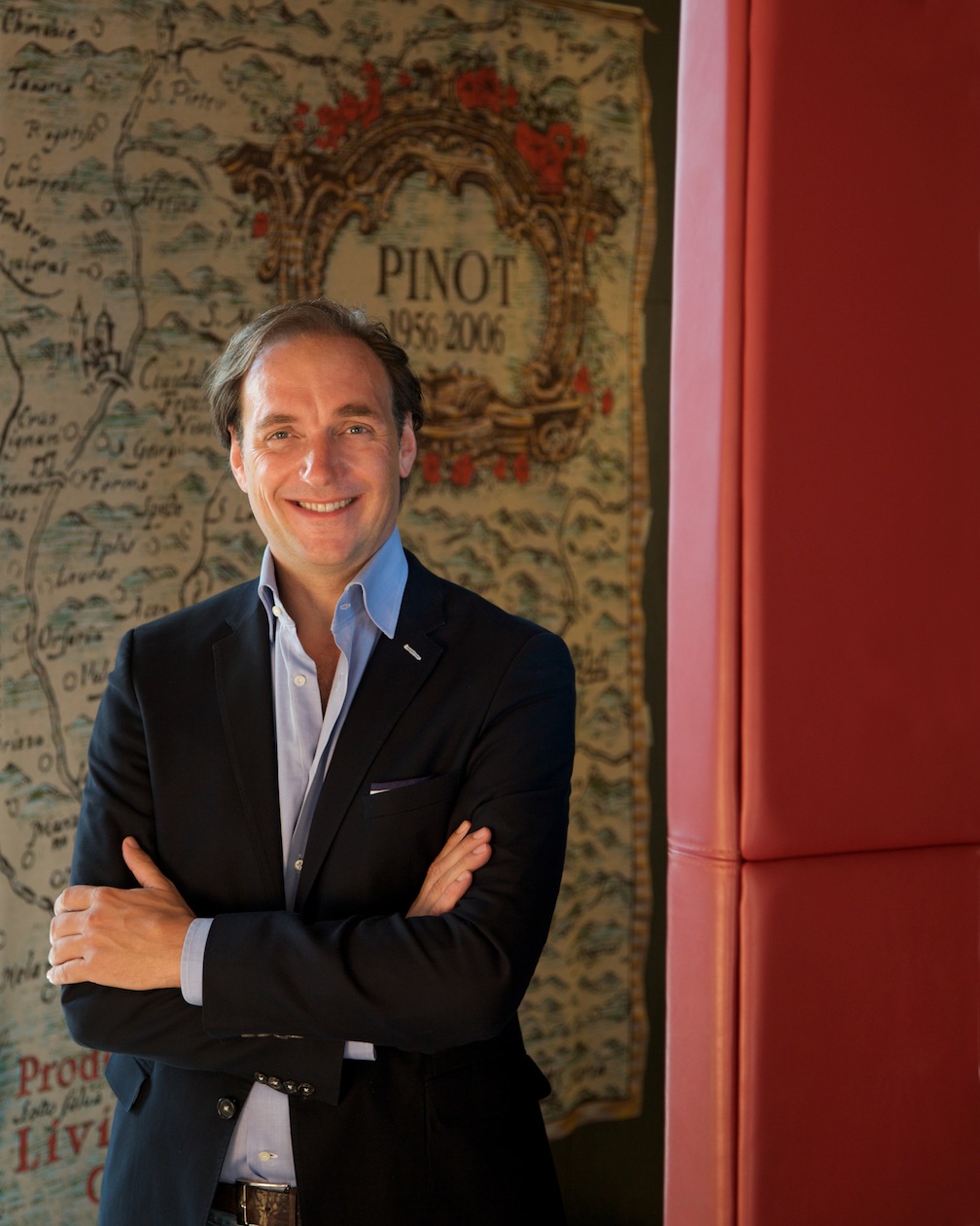 to complete the
alcoholic and malolactic fermentations.
to complete the
alcoholic and malolactic fermentations.
I had occasion to sampling an array
of Felluga’s wines with Andrea, 50 (right), who is in
charge of the winemaking, over pizza and pasta. Upon
tasting the first wine, I was brought back to that
moment in 1978 when I was introduced to Felluga’s wines.
These had the same degree of finesse and specific
terroir that distinguished that first pinot grigio 35
years ago. What's more, I found that unlike 99 percent
of all Italian white wines—and 90 percent of all white
wines—the potential for aging in the Felluga wines was
remarkable, with older bottlings taking on added nuance
with no compromise of freshness and fruit.
Terre
Alte 2011—Pale green gold, very distinctive
nose, aromas of roses, that
is very 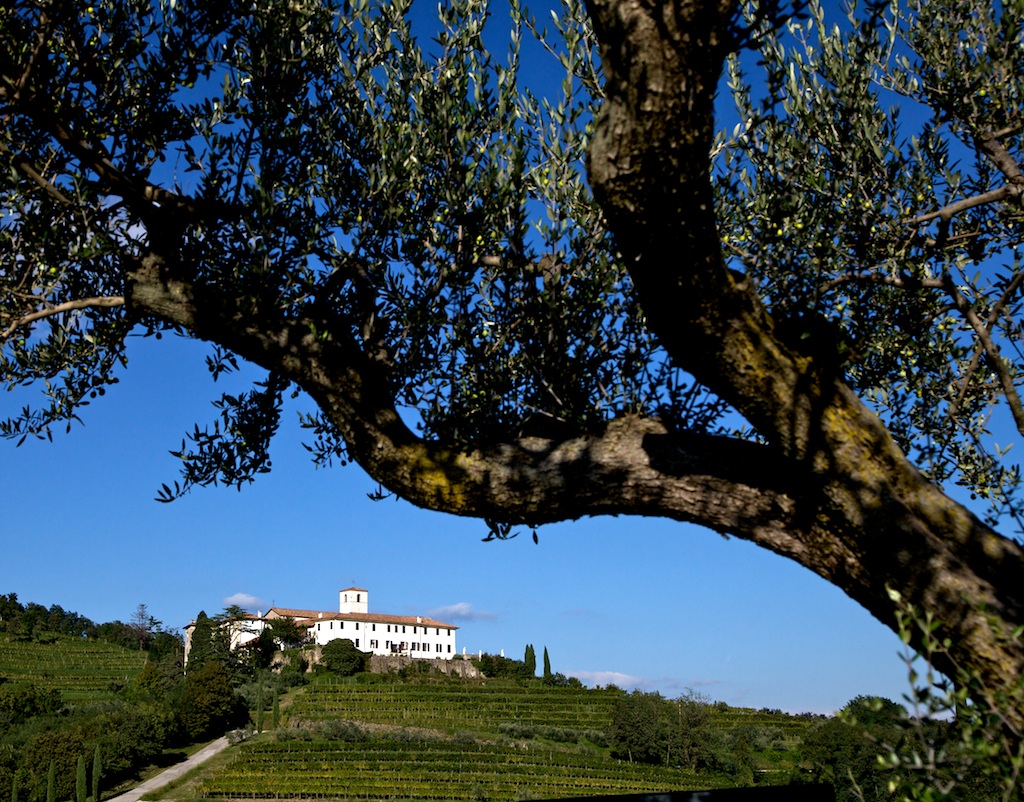 identifiable as Felluga, clean
with fine acid balance.
identifiable as Felluga, clean
with fine acid balance.
Terre Alte 2009—More
velvety, smoother, with a synergy of terroir elements. Bottle with a
screwcap for USA and UK.
Terre
Alte 2008—Not as much complexity as 2009, a
little pepper, quite dry, but the fruit is bright and
makes this ideal with seafood and cheeses.
Terre Alte 2007—Very big mouthful, with grapes
harvested early. A remarkable long lasting wine.
Terre
Alte 2006—Very round, voluptuous showing
remarkable longevity, suggesting all Felluga whites
should be saved for a year or two for true
maturity.
Abbazia
di Rosazzo 2011—Unusual, unique flavor unlike
any other Italian white wine, with lots of spice
from malvasia, ribolla gialla, more fruit, a blend of
friulano, sauvignon blanc, pinot bianco.
❖❖❖
BLOCK THAT
METAPHOR! 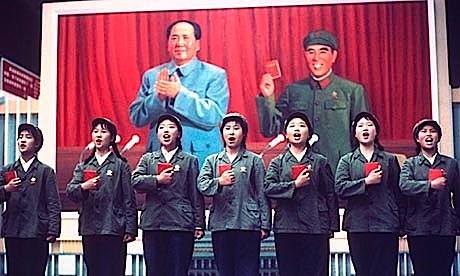
“The Mongolian beef is tender with a subtle kick,
nestled in a pile of plump and juicy veggies, and the
lemon chicken belongs nowhere near a mall food court. It’s as if the menu
graduated with a double major in Chinese and
International studies.”—Justin Williams, “The Melting
Pot,” Cincinnati
Magazine (Nov. 2013).
HANDS FREE WHILE DRIVING TOO!
"The WineRack is a sports bra that lets you sport
up to 750ml (25 oz.) of your favorite beverage. Wear it
to the movies, concerts, ball games — anywhere you can
imagine. Includes a polyurethane bladder and a drinking
tube long enough to route as you wish, along with an
easy-to-use on/off valve to control the flow. Fits sizes
34C-D, 36A-D and 38A-C; In Black."
❖❖❖
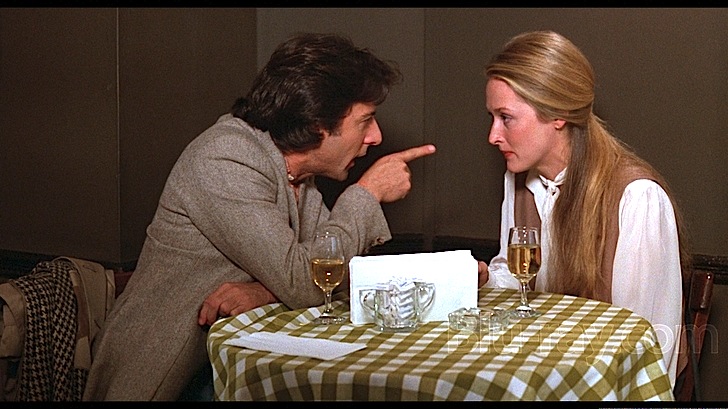 DEPARTMENT OF CORRECTIONS
DEPARTMENT OF CORRECTIONS
❖❖❖
Any of John Mariani's
books below may be ordered from amazon.com.
 |
My latest book, which just won the prize for best book from International Gourmand, written with Jim Heimann and Steven Heller, Menu Design in America, 1850-1985 (Taschen Books), has just appeared, with nearly 1,000 beautiful, historic, hilarious, sometimes shocking menus dating back to before the Civil War and going through the Gilded Age, the Jazz Age, the Depression, the nightclub era of the 1930s and 1940s, the Space Age era, and the age when menus were a form of advertising in innovative explosions of color and modern design. The book is a chronicle of changing tastes and mores and says as much about America as about its food and drink.
“Luxuriating vicariously in the pleasures of this book. . . you can’t help but become hungry. . .for the food of course, but also for something more: the bygone days of our country’s splendidly rich and complex past. Epicureans of both good food and artful design will do well to make it their coffee table’s main course.”—Chip Kidd, Wall Street Journal.
“[The menus] reflect the amazing craftsmanship that many restaurants applied to their bills of fare, and suggest that today’s restaurateurs could learn a lot from their predecessors.”—Rebecca Marx, The Village Voice. |
"Eating Italian will never be the same after reading John Mariani's entertaining and savory gastronomical history of the cuisine of Italy and how it won over appetites worldwide. . . . This book is such a tasteful narrative that it will literally make you hungry for Italian food and arouse your appetite for gastronomical history."--Don Oldenburg, USA Today. "Italian
restaurants--some good, some glitzy--far
outnumber their French rivals. Many of
these establishments are zestfully described
in How Italian Food Conquered the World, an
entertaining and fact-filled chronicle by
food-and-wine correspondent John F.
Mariani."--Aram Bakshian Jr., Wall Street
Journal.
"Equal parts
history, sociology, gastronomy, and just
plain fun, How Italian Food Conquered the
World tells the captivating and delicious
story of the (let's face it) everybody's
favorite cuisine with clarity, verve and
more than one surprise."--Colman Andrews,
editorial director of The Daily
Meal.com. "A fantastic and fascinating
read, covering everything from the influence
of Venice's spice trade to the impact of
Italian immigrants in America and the
evolution of alta cucina. This book will
serve as a terrific resource to anyone
interested in the real story of Italian
food."--Mary Ann Esposito, host of PBS-TV's
Ciao
Italia. "John Mariani has written the
definitive history of how Italians won their
way into our hearts, minds, and
stomachs. It's a story of pleasure over
pomp and taste over technique."--Danny Meyer,
owner of NYC restaurants Union Square Cafe,
Gotham Bar & Grill, The Modern, and
Maialino.
|
 |
 |
 |
 |
 |
 |
 |
 |
 Everett Potter's Travel Report:
Everett Potter's Travel Report: 
 Eating Las Vegas
is the new on-line site for Virtual Gourmet
contributor John A. Curtas., who since 1995
has been commenting on the Las Vegas food
scene and reviewing restaurants for Nevada
Public Radio. He is also the
restaurant critic for KLAS TV, Channel 8 in
Las Vegas, and his past reviews can be
accessed at KNPR.org.
Click on the logo below to go directly to
his site.
Eating Las Vegas
is the new on-line site for Virtual Gourmet
contributor John A. Curtas., who since 1995
has been commenting on the Las Vegas food
scene and reviewing restaurants for Nevada
Public Radio. He is also the
restaurant critic for KLAS TV, Channel 8 in
Las Vegas, and his past reviews can be
accessed at KNPR.org.
Click on the logo below to go directly to
his site.

Tennis Resorts Online: A Critical Guide to the World's Best Tennis Resorts and Tennis Camps, published by ROGER COX, who has spent more than two decades writing about tennis travel, including a 17-year stretch for Tennis magazine. He has also written for Arthur Frommer's Budget Travel, New York Magazine, Travel & Leisure, Esquire, Money, USTA Magazine, Men's Journal, and The Robb Report. He has authored two books-The World's Best Tennis Vacations (Stephen Greene Press/Viking Penguin, 1990) and The Best Places to Stay in the Rockies (Houghton Mifflin, 1992 & 1994), and the Melbourne (Australia) chapter to the Wall Street Journal Business Guide to Cities of the Pacific Rim (Fodor's Travel Guides, 1991).


MARIANI'S VIRTUAL GOURMET
NEWSLETTER is published weekly. Editor/Publisher: John
Mariani.
Contributing Writers: Christopher Mariani, Robert Mariani,
John A. Curtas, Edward Brivio, Mort Hochstein,
Suzanne Wright, and Brian Freedman. Contributing
Photographers: Galina Stepanoff-Dargery,
Bobby Pirillo. Technical Advisor: Gerry McLoughlin.
© copyright John Mariani 2013
